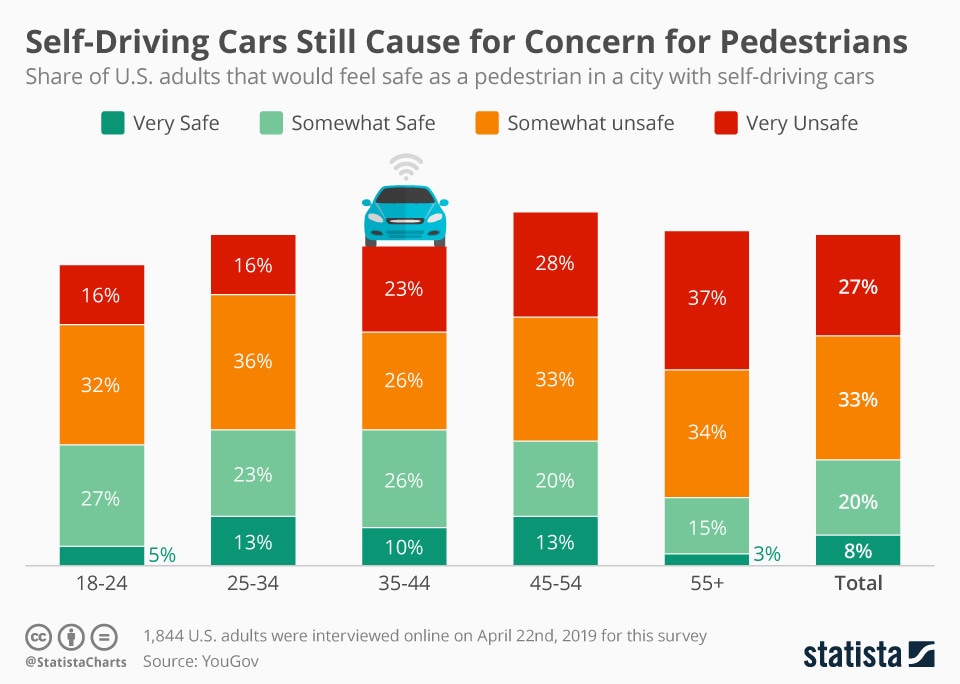We don't know how autonomous vehicles will depreciate – and that's a problem

What if repair and maintenance costs and injury rates for AVs are higher than anticipated? Image: REUTERS/Darrin Zammit Lupi

Get involved with our crowdsourced digital platform to deliver impact at scale
Stay up to date:
Emerging Technologies
Autonomous vehicles (AVs) will have different depreciation patterns than current light passenger vehicles and that pattern is, as yet, unknown. The industry knows with decent accuracy what the maintenance and repair costs for cars, as we know them, are, but for AVs, these factors are unknown. Additionally, it is unclear what the lifecycle of AVs will be.
Depreciation represents how much of a car’s value gets used over time and how much value is lost because of more sophisticated replacements. Factors affecting depreciation include: the number of miles driven, condition of the vehicle including interior, mechanical parts, software, body, age of the car and location. The value of the vehicle is measured by the used car market, which is a local market governed by the classic laws of supply and demand. For current vehicles, driving more than 10,000 miles a year greatly increases the rate of depreciation.
It is assumed that AVs operating as a fleet will be utilized at a much higher rate than current vehicles, possibly 70% versus about 5% for personally owned vehicles. While figuring out the replacement pattern for brakes, tires, windshield wipers and the like could be fairly straightforward, it is much more difficult to know the depreciation and replacement rate for high definition cameras, radar, LiDar, sonar and other parts in the technology stack.
The taxi and rental car industries are a good proxy for understanding depreciation costs at higher utilization rates as well as the type of wear and tear to be expected. However, there is no way to know with certainty the depreciation pace of autonomous components until they have been operating for years.
Nor is there a good way to understand how AVs will perform in accidents. What are the expected personal bodily injuries or the repair and maintenance costs? Some electric vehicles with ADAS (advanced driver-awareness) systems currently on the market are more expensive to insure for collision damage than even many luxury makes.
AVs could avoid many of the accidents that result from driver error, but they will still be operating on roads with non-AVs and they will be involved in accidents. Accident rates could go down as AVs become the majority of cars on the road, but, alas, in the near term, AVs will not be able to avoid all accidents while there are vehicles still being driven by inattentive humans.

If it turns out that AVs have higher repair and maintenance costs, and greater rates of bodily injury, these higher costs will have to be borne by the operator of the AV fleet. Higher operating costs from insurance and fleet replacement will ultimately impact the price we pay for the autonomous movement of people and goods.
Forecasting these unknown costs will be a challenge for companies with little experience of dealing with the depreciation of highly utilized, expensive assets, like a car. Transportation network companies do not carry the cost of depreciation of their drivers’ cars on their balance sheet. Most auto-makers are not familiar with managing depreciating assets outside of their captive finance business, and, even then, they often get residual values wrong to the detriment of their profitability.
We are seeing these economic factors have an effect on micro-transit scooter companies. Scooters do not last long and are expensive to replace, straining business models. Many technology companies entering the robo-taxi business do not have a long history of owning assets worth tens of thousands of dollars that get used by the general public 17 hours a day, nor do they know the price riders are willing to pay.
Furthermore, it is unknown how AVs will be disposed of at the end of their useful life. Cars today are scrapped, auctioned, exported and/or disassembled with valuable parts sold off. We have no idea what this will look like for AVs with electric powertrains (the components that generate and then deliver power to the road surface).
There has been some discussion about a self-driving vehicle being an appreciating rather than a depreciating asset. But there are simply too many unknowns for this to be the case, from insurance costs, parts failures and replacement cycles; to under-developed, second-hand and scrappage markets to really have a good sense. What we do know for certain is that uncertainty will dominate for years to come.
Don't miss any update on this topic
Create a free account and access your personalized content collection with our latest publications and analyses.
License and Republishing
World Economic Forum articles may be republished in accordance with the Creative Commons Attribution-NonCommercial-NoDerivatives 4.0 International Public License, and in accordance with our Terms of Use.
The views expressed in this article are those of the author alone and not the World Economic Forum.
The Agenda Weekly
A weekly update of the most important issues driving the global agenda
You can unsubscribe at any time using the link in our emails. For more details, review our privacy policy.
More on Emerging TechnologiesSee all
Ella Yutong Lin and Kate Whiting
April 23, 2024
Andre S. Yoon and Kyoung Yeon Kim
April 23, 2024
Simon Torkington
April 23, 2024
Thong Nguyen
April 23, 2024
Kalin Anev Janse and José Parra Moyano
April 22, 2024
Sebastian Buckup
April 19, 2024






